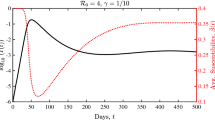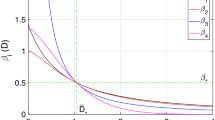Abstract
Infectious diseases are now widely analyzed by compartmental models. This paper introduces a SIR model coupled with a social mobility model (SMM). After discretization by a forward Euler Method, and a mixed type Euler method (structured with both forward and backward Euler elements), we obtained a difference equations model for our social mobility model. We calculate the basic reproduction number \(R_{0}\) using the next-generation matrix method. When \(R_{0}<1\), there will be a disease-free equilibrium (DFE), and \(R_{0}<1\) implies DFE will be locally asymptotically stable, while \(R_{0}>1\) implies DFE is unstable. When \(R_{0}=1\), DFE may stable or unstable. Then we obtain a hyperbolic forward Kolmogorov equation corresponding to the SIR epidemic model. We also generate the hyperbolic forward Kolmogorov equations for the SIR model with SMM between 2 locations.
Access this chapter
Tax calculation will be finalised at checkout
Purchases are for personal use only
Similar content being viewed by others
References
Murray, J.D.: Mathematical Biology, 3rd edn. Springer, Berlin, Heidelberg (2002)
Anderson, Roy M., May, Robert M.: Infectious Diseases of Humans Daynamics and Control, 1st edn. Oxford University Press, New York (1991)
Hethecote, H.W.: The mathematics of infectious diseases. SIAM Rev. 42(4), 599–653
Sattenspiel, L., Dietz, K.: A structured epidemic model incorporating geographic mobility among regions. Math. Biosci. 128(71–91) (1995)
Bharti, N., Xia, Y., Bjornstad, O.N., Grenfell, B.T.: Measles on the edge: coastal heterogeneities and infection dynamics. PLoS One 3(4), e1941 (2008)
Skufca, J.D., Ben Avraham, D.: A model of human population motion. [physics.soc-ph], (arXiv:1006.1301v2), 7 Oct 2014
Arino, J., van den Driessche, P.: A multi-city epidemic model. Math. Popul. Stud. 10, 175–193 (2003)
Arino, J., van den Driessche, P.: The basic reproduction number in a multi-city compartmental epidemic model. In: Positive Systems. LNCIS, vol. 294, pp. 135–142 (2003)
Ruan, S., Wang, W., Levin, S.A.: The effect of global travel on the spread of SARS. Math. Bopsci. Eng. 3(1) (2006)
Ramani, A., Carstea, A.S., Willox, R., Grammaticos, B.: Oscillating epidemics: a discrete-time model. Phys. A 333, 278–292) (2004)
Feng, Z., Velasco-Hernandez, J., Tapia-Santos, B., Leite, M.C.A.: A model for coupling within-host and between-host dynamics in an infectious disease. Nonlinear Dyn. (2012). https://doi.org/10.1007/s11071-011-0291-0(68:401411)
van den Driessche, P., Watmough, J.: Reproduction numbers and sub-threshold endemic equilibria for compartmental models of disease transmission. Math. Biosci. 180, 29–8 (2002)
Chalub, F.A.C.C., Souza, M.O.: The SIR epidemic model from a PDE point of view. Math. Comput. Model. 53, 1568–1574 (2011)
Chalub, F.A.C.C., Souza, M.O.: From discrete to continuous evolution models: a unifying approach to drift-diffusion and replicator dynamics. Theor. Popul. Biol. 76, 268–277 (2009)
Allen, L.J.S.: Some discrete-time SI, SIR, and SIS epidemic models. Math. Biosci. 124(1), 83–105 (1994)
Allen, L.J.S., van den Driessche, P.: The basic reproduction number in some discrete-time epidemic models. J. Diff. Equ. Appl. 14(10–11) (2008)
Jang, S., Elaydi, S.: Difference equations from discretization of a continuous epidemic model with immigration of infectives. Can. Appl. Math. Q. 11, 93–105 (2003)
Acknowledgments
I would like to thank Professor Joseph D. Skufca for his support and encouragement. He kindly read my paper and offered invaluable detailed advice on grammar, organization, and the theme of the paper. I sincerely thank my parents and friends, who provide pieces of advice and financial support. The product of this research paper would not be possible without all of them.
Author information
Authors and Affiliations
Corresponding author
Editor information
Editors and Affiliations
Rights and permissions
Copyright information
© 2020 Springer Nature Switzerland AG
About this paper
Cite this paper
LI, Y., Xu, J. (2020). Population Motivated Discrete-Time Disease Models. In: Baigent, S., Bohner, M., Elaydi, S. (eds) Progress on Difference Equations and Discrete Dynamical Systems. ICDEA 2019. Springer Proceedings in Mathematics & Statistics, vol 341. Springer, Cham. https://doi.org/10.1007/978-3-030-60107-2_15
Download citation
DOI: https://doi.org/10.1007/978-3-030-60107-2_15
Published:
Publisher Name: Springer, Cham
Print ISBN: 978-3-030-60106-5
Online ISBN: 978-3-030-60107-2
eBook Packages: Mathematics and StatisticsMathematics and Statistics (R0)




